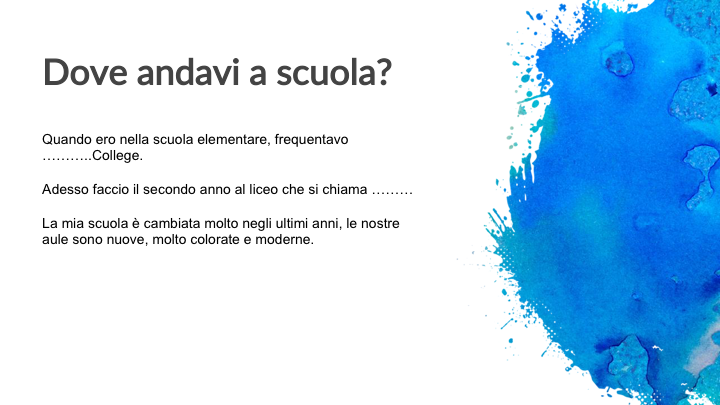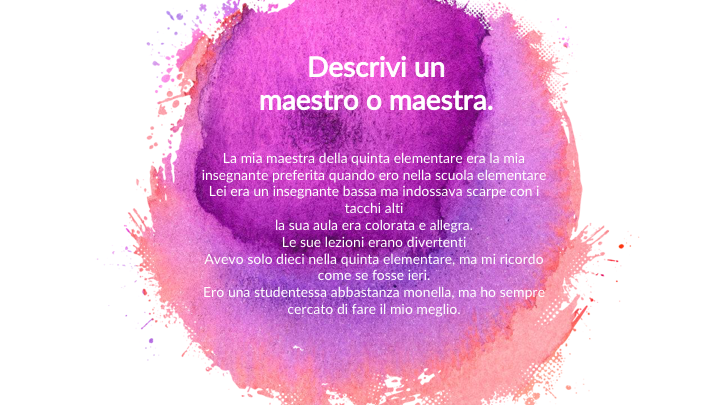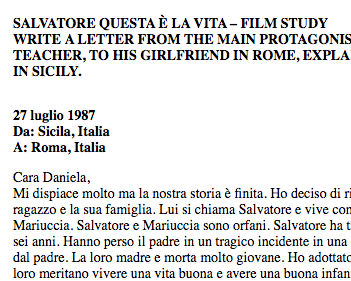- Home
- Resources
- Work samples
- Samples
- La mia infanzia - AT
Languages: Italian
Years 9 and 10 (Year 7 entry)
Satisfactory
La mia infanzia
Summary of task
Students had been learning to discuss their childhood memories using the correct past tenses in Italian. Students had learnt the present perfect and imperfect tenses in Italian and the focus of this task was to demonstrate appropriate use of these tenses when discussing past events.
Students were asked to create a presentation for the class about their childhood memories.
Students were given the following prompts:
- Dove sei nato/nata?
- Dove abitavi da piccolo/a?
- Descrivi la tua casa da piccolo/a.
- Avevi un animale domestico?
- Dove andavi a scuola elementare?
- Descrivi un insegnante preferito.
- Andavi in vacanze.
- Che erano i tuoi amici?
- Che cosa ti piaceva mangiare?/non ti piaceva mangiare?
Achievement standard
By the end of Year 10, students use a range of everyday language both orally and in writing to exchange information about their personal, social, local and about broader issues of personal significance. They communicate thoughts and opinions; make comparisons and contrasts (for example, a differenza di; invece), and offer reasons for points of view, opinions and preferences. They express desires and plans for the future. They give presentations, and formulate and respond to a range of questions. They interpret information and attitudes in a range of informational and imaginative texts. They create written texts such as descriptions, narratives and recounts that convey experiences, ideas and emotions. They give detailed descriptions; describe and relate episodes in time (for example, prima … poi … infine); and qualify statements, for example, through the use of relative clauses. They use simple subject–verb–object constructions, extending or qualifying their message by, for example, adding complements or using modal verbs or comparatives. They produce bilingual texts, plan what needs to be communicated to particular audiences and consider different perspectives.
Students use metalanguage to analyse and discuss features of language choice and use and cultural practice. They analyse texts, identifying features such as tone, sequences and relationships of events in time. They communicate their thoughts with awareness of different perspectives on issues or practices being discussed. They explain how Italian language use varies according to context, purpose and mode. They identify social and cultural practices of Italians in Italy and in the diaspora, including communities in Australia. They identify particular issues relating to translating between Italian and English, such as words with similar meanings and 'false friends, and identify certain concepts that cannot be translated readily from Italian to English and from English into Italian. They reflect on ways in which language and culture together create meanings, and on ways in which their own linguistic and cultural assumptions come into play in using and learning Italian. They demonstrate understanding of the role of language and culture in shaping experience, and the ways in which their own past experiences shape their identity.

 1
Annotation 1
1
Annotation 1
Uses the 'passato prossimo' past tense correctly 2 Annotation 2
Applies correct word order for preceding object 3 Annotation 3
Understands when to use the 'imperfetto' tense 4 Annotation 4
Able to move from the past to the present conjugation
-
Annotations
-
1
Annotation 1
Uses the 'passato prossimo' past tense correctly -
2
Annotation 2
Applies correct word order for preceding object -
3
Annotation 3
Understands when to use the 'imperfetto' tense -
4
Annotation 4
Able to move from the past to the present conjugation
 1
Annotation 1
1
Annotation 1
Uses conjunctions to write complex sentences 2 Annotation 2
Demonstrates understanding of agreement in number and gender between the subject and the verb 'essere' conjugated in the 'passato prossimo'
-
Annotations
-
1
Annotation 1
Uses conjunctions to write complex sentences -
2
Annotation 2
Demonstrates understanding of agreement in number and gender between the subject and the verb 'essere' conjugated in the 'passato prossimo'
 1
Annotation 1
1
Annotation 1
Begins sentence with a relative clause to establish a time frame 2 Annotation 2
Agrees articulated 'di' with regular and irregular nouns
-
Annotations
-
1
Annotation 1
Begins sentence with a relative clause to establish a time frame -
2
Annotation 2
Agrees articulated 'di' with regular and irregular nouns
 1
Annotation 1
1
Annotation 1
Uses the correct word, to express, to attend in Italian 2 Annotation 2
Understands not to always use literal translations from English to Italian 3 Annotation 3
Agrees adjectives and articulated prepositions to masculine and feminine nouns in the plural
-
Annotations
-
1
Annotation 1
Uses the correct word, to express, to attend in Italian -
2
Annotation 2
Understands not to always use literal translations from English to Italian -
3
Annotation 3
Agrees adjectives and articulated prepositions to masculine and feminine nouns in the plural
 1
Annotation 1
1
Annotation 1
Gives an extended description and explanation to enhance meaning 2 Annotation 2
Uses a learnt expression correctly in the subjunctive mood 3 Annotation 3
Uses an idiomatic expression correctly to describe self 4 Annotation 4
Compares and contrasts self in the past and present
-
Annotations
-
1
Annotation 1
Gives an extended description and explanation to enhance meaning -
2
Annotation 2
Uses a learnt expression correctly in the subjunctive mood -
3
Annotation 3
Uses an idiomatic expression correctly to describe self -
4
Annotation 4
Compares and contrasts self in the past and present
 1
Annotation 1
1
Annotation 1
Conjugates the imperfect in the singular and in the plural forms 2 Annotation 2
Understands context when 'pasato prossimo' must be used 3 Annotation 3
Conjugates the verb 'piacere' correctly in the 'imperfetto' and understands the literal construction of 'to like' cannot be translated between Italian and English 4 Annotation 4
Uses 'avere' expression correctly to express fear
-
Annotations
-
1
Annotation 1
Conjugates the imperfect in the singular and in the plural forms -
2
Annotation 2
Understands context when 'pasato prossimo' must be used -
3
Annotation 3
Conjugates the verb 'piacere' correctly in the 'imperfetto' and understands the literal construction of 'to like' cannot be translated between Italian and English -
4
Annotation 4
Uses 'avere' expression correctly to express fear
 1
Annotation 1
1
Annotation 1
Uses an idiomatic 'fare' expression that cannot be translated literally
-
Annotations
-
1
Annotation 1
Uses an idiomatic 'fare' expression that cannot be translated literally
 1
Annotation 1
1
Annotation 1
Describes preferences then and now with adverbs 'allora e ancora oggi' 2 Annotation 2
Places adverb correctly between auxiliary and past participle
-
Annotations
-
1
Annotation 1
Describes preferences then and now with adverbs 'allora e ancora oggi' -
2
Annotation 2
Places adverb correctly between auxiliary and past participle






